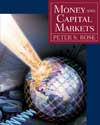 |  Money and Capital Markets: Financial Institutions and Instruments in a Global Marketplace, 8/e Peter Rose,
Texas A & M University
Key Sources of Financial Information
Chapter SummaryThis chapter examines the key role that information plays in the money and capital markets
and the financial system. Among its key points are those items listed below.
- An unimpeded flow of relevant, low-cost information is vital to the efficient and effective
functioning of the financial markets and the financial system. If the scarce resource
of credit is to be allocated efficiently and an ample flow of savings made available for
investment, accurate financial information must be made readily available at low cost to
all market participants.
- There are two different types of markets operating within the financial system every
day: an information market and a market for financial assets. The two different types of
markets must work together in a coordinated fashion to accomplish the desired end result
—directing the flow of scarce loanable funds (coming primarily from savings) toward
their most profitable and beneficial uses (primarily into investments that help the
economy, our standard of living, and jobs to grow).
- If the market for financial information is truly efficient, so that all relevant information
for valuing financial assets is readily available at negligible cost, financial assets will be
correctly priced based on their expected return and risk, and scarce resources will flow
to those uses of funds promising the highest expected returns.
- When asymmetries exist in information flow and availability, however, the financial
marketplace will operate imperfectly. Some market participants, armed with special information
not broadly available to all market participants, will earn excess profits (that
is, generate returns that exceed the normal rate of return for the amount of risk taken
on). Scarce resources will then be allocated less efficiently than otherwise might be the
case. Research evidence to date suggests that most financial markets are efficient but
that important asymmetries still remain.
- Today there is a wide array of different information sources available to the general public.
Among the more prominent examples are financial newssheets such as The Wall
Street Journal, Fortune Magazine, and Forbes. Daily stock and bond market reports are
not only provided extensively via the World Wide Web and through multiple Internet
sources but also from local newspapers in most cities around the globe. Key sources of
public information about individual companies include condition reports provided by
the Securities and Exchange Commission, Standard & Poor’s Corporation, and Moody’s
Investors Service. Economies in the United States and around the globe are tracked
through such sources as The Economist, the Federal Reserve Bulletin, and The Survey
of Current Business. Finally, data on financial transactions from the whole United
States’ economy is published quarterly by the Board of Governors of the Federal Reserve
System through the Flow of Funds Accounts.
- In this chapter, our principal focus has been on five broad categories of financial information
available today: debt security prices and yields, stock prices and dividend yields,
the financial condition of security issuers, general conditions in the economy and financial
system, and social accounting data. The purpose of this chapter has been to give the
student of the financial system a broad overview of the kinds and quality of information
currently available to the public. Knowing where to find relevant, up-to-date information
is an essential ingredient in the process of solving economic and financial problems.
|
|




 2003 McGraw-Hill Higher Education
2003 McGraw-Hill Higher Education